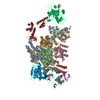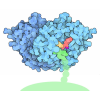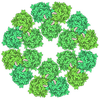+ Open data
Open data
- Basic information
Basic information
| Entry | Database: PDB / ID: 7d43 | |||||||||
|---|---|---|---|---|---|---|---|---|---|---|
| Title | eIF2B-eIF2(aP), aPg complex | |||||||||
 Components Components |
| |||||||||
 Keywords Keywords | TRANSLATION / Complex / Translational control | |||||||||
| Function / homology |  Function and homology information Function and homology informationmale germ cell proliferation / regulation of translation in response to endoplasmic reticulum stress / translation initiation ternary complex / glial limiting end-foot / HRI-mediated signaling / response to kainic acid / Cellular response to mitochondrial stress / eukaryotic translation initiation factor 2B complex / response to manganese-induced endoplasmic reticulum stress / positive regulation of type B pancreatic cell apoptotic process ...male germ cell proliferation / regulation of translation in response to endoplasmic reticulum stress / translation initiation ternary complex / glial limiting end-foot / HRI-mediated signaling / response to kainic acid / Cellular response to mitochondrial stress / eukaryotic translation initiation factor 2B complex / response to manganese-induced endoplasmic reticulum stress / positive regulation of type B pancreatic cell apoptotic process / negative regulation of translational initiation in response to stress / Response of EIF2AK1 (HRI) to heme deficiency / Recycling of eIF2:GDP / PERK-mediated unfolded protein response / methionyl-initiator methionine tRNA binding / PERK regulates gene expression / regulation of translational initiation in response to stress / eukaryotic translation initiation factor 2 complex / cytoplasmic translational initiation / translation factor activity, RNA binding / protein-synthesizing GTPase / guanyl-nucleotide exchange factor complex / formation of translation preinitiation complex / oligodendrocyte development / astrocyte development / eukaryotic 48S preinitiation complex / astrocyte differentiation / regulation of translational initiation / Formation of the ternary complex, and subsequently, the 43S complex / Ribosomal scanning and start codon recognition / Translation initiation complex formation / Response of EIF2AK4 (GCN2) to amino acid deficiency / mitophagy / GTP hydrolysis and joining of the 60S ribosomal subunit / L13a-mediated translational silencing of Ceruloplasmin expression / positive regulation of translational initiation / response to glucose / ovarian follicle development / stress granule assembly / translation initiation factor binding / response to endoplasmic reticulum stress / myelination / translation initiation factor activity / cellular response to amino acid starvation / guanyl-nucleotide exchange factor activity / hippocampus development / central nervous system development / translational initiation / ABC-family proteins mediated transport / PKR-mediated signaling / response to peptide hormone / cytoplasmic stress granule / male gonad development / cellular response to UV / ribosome binding / regulation of translation / T cell receptor signaling pathway / cellular response to heat / cellular response to oxidative stress / response to heat / in utero embryonic development / cadherin binding / positive regulation of apoptotic process / GTPase activity / mRNA binding / synapse / GTP binding / mitochondrion / RNA binding / extracellular exosome / ATP binding / identical protein binding / membrane / nucleus / metal ion binding / plasma membrane / cytosol / cytoplasm Similarity search - Function | |||||||||
| Biological species |  Homo sapiens (human) Homo sapiens (human) | |||||||||
| Method | ELECTRON MICROSCOPY / single particle reconstruction / cryo EM / Resolution: 4.3 Å | |||||||||
 Authors Authors | Kashiwagi, K. / Ito, T. | |||||||||
| Funding support |  Japan, 2items Japan, 2items
| |||||||||
 Citation Citation |  Journal: Mol Cell / Year: 2021 Journal: Mol Cell / Year: 2021Title: ISRIB Blunts the Integrated Stress Response by Allosterically Antagonising the Inhibitory Effect of Phosphorylated eIF2 on eIF2B. Authors: Alisa F Zyryanova / Kazuhiro Kashiwagi / Claudia Rato / Heather P Harding / Ana Crespillo-Casado / Luke A Perera / Ayako Sakamoto / Madoka Nishimoto / Mayumi Yonemochi / Mikako Shirouzu / ...Authors: Alisa F Zyryanova / Kazuhiro Kashiwagi / Claudia Rato / Heather P Harding / Ana Crespillo-Casado / Luke A Perera / Ayako Sakamoto / Madoka Nishimoto / Mayumi Yonemochi / Mikako Shirouzu / Takuhiro Ito / David Ron /   Abstract: The small molecule ISRIB antagonizes the activation of the integrated stress response (ISR) by phosphorylated translation initiation factor 2, eIF2(αP). ISRIB and eIF2(αP) bind distinct sites in ...The small molecule ISRIB antagonizes the activation of the integrated stress response (ISR) by phosphorylated translation initiation factor 2, eIF2(αP). ISRIB and eIF2(αP) bind distinct sites in their common target, eIF2B, a guanine nucleotide exchange factor for eIF2. We have found that ISRIB-mediated acceleration of eIF2B's nucleotide exchange activity in vitro is observed preferentially in the presence of eIF2(αP) and is attenuated by mutations that desensitize eIF2B to the inhibitory effect of eIF2(αP). ISRIB's efficacy as an ISR inhibitor in cells also depends on presence of eIF2(αP). Cryoelectron microscopy (cryo-EM) showed that engagement of both eIF2B regulatory sites by two eIF2(αP) molecules remodels both the ISRIB-binding pocket and the pockets that would engage eIF2α during active nucleotide exchange, thereby discouraging both binding events. In vitro, eIF2(αP) and ISRIB reciprocally opposed each other's binding to eIF2B. These findings point to antagonistic allostery in ISRIB action on eIF2B, culminating in inhibition of the ISR. | |||||||||
| History |
|
- Structure visualization
Structure visualization
| Movie |
 Movie viewer Movie viewer |
|---|---|
| Structure viewer | Molecule:  Molmil Molmil Jmol/JSmol Jmol/JSmol |
- Downloads & links
Downloads & links
- Download
Download
| PDBx/mmCIF format |  7d43.cif.gz 7d43.cif.gz | 725 KB | Display |  PDBx/mmCIF format PDBx/mmCIF format |
|---|---|---|---|---|
| PDB format |  pdb7d43.ent.gz pdb7d43.ent.gz | 581.7 KB | Display |  PDB format PDB format |
| PDBx/mmJSON format |  7d43.json.gz 7d43.json.gz | Tree view |  PDBx/mmJSON format PDBx/mmJSON format | |
| Others |  Other downloads Other downloads |
-Validation report
| Summary document |  7d43_validation.pdf.gz 7d43_validation.pdf.gz | 810.6 KB | Display |  wwPDB validaton report wwPDB validaton report |
|---|---|---|---|---|
| Full document |  7d43_full_validation.pdf.gz 7d43_full_validation.pdf.gz | 942.6 KB | Display | |
| Data in XML |  7d43_validation.xml.gz 7d43_validation.xml.gz | 120.7 KB | Display | |
| Data in CIF |  7d43_validation.cif.gz 7d43_validation.cif.gz | 189.6 KB | Display | |
| Arichive directory |  https://data.pdbj.org/pub/pdb/validation_reports/d4/7d43 https://data.pdbj.org/pub/pdb/validation_reports/d4/7d43 ftp://data.pdbj.org/pub/pdb/validation_reports/d4/7d43 ftp://data.pdbj.org/pub/pdb/validation_reports/d4/7d43 | HTTPS FTP |
-Related structure data
| Related structure data |  30568MC  7d44C  7d45C  7d46C M: map data used to model this data C: citing same article ( |
|---|---|
| Similar structure data |
- Links
Links
- Assembly
Assembly
| Deposited unit | 
|
|---|---|
| 1 |
|
- Components
Components
-Translation initiation factor eIF-2B subunit ... , 5 types, 10 molecules ABCDEFGHIJ
| #1: Protein | Mass: 33754.148 Da / Num. of mol.: 2 Source method: isolated from a genetically manipulated source Source: (gene. exp.)  Homo sapiens (human) / Gene: EIF2B1, EIF2BA / Production host: Homo sapiens (human) / Gene: EIF2B1, EIF2BA / Production host:  #2: Protein | Mass: 39039.547 Da / Num. of mol.: 2 Source method: isolated from a genetically manipulated source Source: (gene. exp.)  Homo sapiens (human) / Gene: EIF2B2, EIF2BB / Production host: Homo sapiens (human) / Gene: EIF2B2, EIF2BB / Production host:  #3: Protein | Mass: 50304.230 Da / Num. of mol.: 2 Source method: isolated from a genetically manipulated source Source: (gene. exp.)  Homo sapiens (human) / Gene: EIF2B3 / Production host: Homo sapiens (human) / Gene: EIF2B3 / Production host:  #4: Protein | Mass: 57640.168 Da / Num. of mol.: 2 Source method: isolated from a genetically manipulated source Source: (gene. exp.)  Homo sapiens (human) / Gene: EIF2B4, EIF2BD / Production host: Homo sapiens (human) / Gene: EIF2B4, EIF2BD / Production host:  #5: Protein | Mass: 80466.609 Da / Num. of mol.: 2 Source method: isolated from a genetically manipulated source Source: (gene. exp.)  Homo sapiens (human) / Gene: EIF2B5, EIF2BE / Production host: Homo sapiens (human) / Gene: EIF2B5, EIF2BE / Production host:  |
|---|
-Eukaryotic translation initiation factor 2 subunit ... , 3 types, 4 molecules KLMP
| #6: Protein | Mass: 36241.156 Da / Num. of mol.: 2 Source method: isolated from a genetically manipulated source Source: (gene. exp.)  Homo sapiens (human) / Gene: EIF2S1, EIF2A / Production host: Homo sapiens (human) / Gene: EIF2S1, EIF2A / Production host:  Homo sapiens (human) / References: UniProt: P05198 Homo sapiens (human) / References: UniProt: P05198#7: Protein | | Mass: 38454.484 Da / Num. of mol.: 1 Source method: isolated from a genetically manipulated source Source: (gene. exp.)  Homo sapiens (human) / Gene: EIF2S2, EIF2B / Production host: Homo sapiens (human) / Gene: EIF2S2, EIF2B / Production host:  Homo sapiens (human) / References: UniProt: P20042 Homo sapiens (human) / References: UniProt: P20042#8: Protein | | Mass: 51178.406 Da / Num. of mol.: 1 Source method: isolated from a genetically manipulated source Source: (gene. exp.)  Homo sapiens (human) / Gene: EIF2S3, EIF2G / Production host: Homo sapiens (human) / Gene: EIF2S3, EIF2G / Production host:  Homo sapiens (human) / References: UniProt: P41091, protein-synthesizing GTPase Homo sapiens (human) / References: UniProt: P41091, protein-synthesizing GTPase |
|---|
-Details
| Has ligand of interest | N |
|---|
-Experimental details
-Experiment
| Experiment | Method: ELECTRON MICROSCOPY |
|---|---|
| EM experiment | Aggregation state: PARTICLE / 3D reconstruction method: single particle reconstruction |
- Sample preparation
Sample preparation
| Component |
| ||||||||||||||||||||||||
|---|---|---|---|---|---|---|---|---|---|---|---|---|---|---|---|---|---|---|---|---|---|---|---|---|---|
| Source (natural) |
| ||||||||||||||||||||||||
| Source (recombinant) |
| ||||||||||||||||||||||||
| Buffer solution | pH: 7.5 | ||||||||||||||||||||||||
| Specimen | Embedding applied: NO / Shadowing applied: NO / Staining applied: NO / Vitrification applied: YES | ||||||||||||||||||||||||
| Vitrification | Cryogen name: ETHANE |
- Electron microscopy imaging
Electron microscopy imaging
| Experimental equipment |  Model: Talos Arctica / Image courtesy: FEI Company |
|---|---|
| Microscopy | Model: FEI TECNAI ARCTICA |
| Electron gun | Electron source:  FIELD EMISSION GUN / Accelerating voltage: 200 kV / Illumination mode: FLOOD BEAM FIELD EMISSION GUN / Accelerating voltage: 200 kV / Illumination mode: FLOOD BEAM |
| Electron lens | Mode: BRIGHT FIELD |
| Image recording | Electron dose: 50 e/Å2 / Film or detector model: GATAN K2 SUMMIT (4k x 4k) |
- Processing
Processing
| Software | Name: PHENIX / Version: 1.17.1_3660: / Classification: refinement | ||||||||||||||||||||||||
|---|---|---|---|---|---|---|---|---|---|---|---|---|---|---|---|---|---|---|---|---|---|---|---|---|---|
| CTF correction | Type: PHASE FLIPPING ONLY | ||||||||||||||||||||||||
| 3D reconstruction | Resolution: 4.3 Å / Resolution method: FSC 0.143 CUT-OFF / Num. of particles: 66721 / Symmetry type: POINT | ||||||||||||||||||||||||
| Refine LS restraints |
|
 Movie
Movie Controller
Controller














 PDBj
PDBj


















